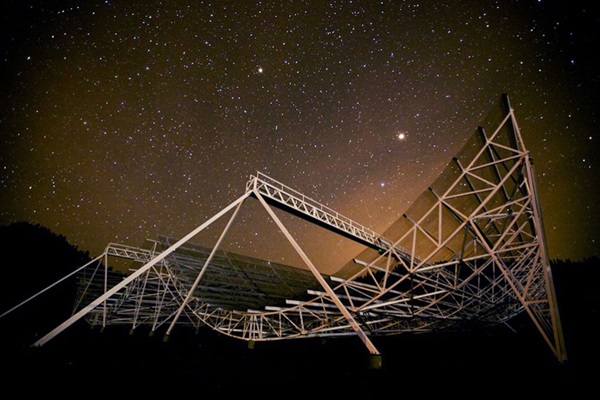Fast Radio Bursts (FRBs) detected
Very strong radio signals have been detected by the Canadian Hydrogen Intensity mapping Experiment (CHIME) observatory in British Columbia in Canada. They appear to originate from a very distant galaxy, around 1.5 billion light years away. These types of signals have been detected before, but by different telescopes and from a variety of different sources.
Fast Radio Bursts are short, bright and extremely powerful radio waves. They tend to be seemingly random, one-off events, which makes them difficult to study and impossible to predict. Only a single pulse (known as FRB 121102) has been seen to blast more than once.
The first FRB to be observed was in 2007. Since then, more than fifty have been detected. Scientists believe that there may hundreds, possible thousands of FRB’s every day, and that we will detect more of them as more powerful telescopes are brought online across the world. Indeed, the CHIME radio telescope only began observations in 2018, detecting thirteen of these FRB’s within a short period of operation. This implies that there may well be more of them than we thought, and as more are discovered, so we may be able to work out what they are and where they come from.
One of the signals detected by the CHIME observatory is of particular interest, because it is has a repeating pattern. Several possible explanations as to the cause of these signals have been proposed. These include rapidly rotating, highly magnetic neutron stars, or perhaps two neutron stars colliding or merging. Black holes have also been implicated, but FRB’s associated with these tend to come from only the very largest galaxies, whereas the latest observations appear to come from very ordinary ones.
But of course the headline grabbing theory is that it is all due to aliens communicating from afar. The tabloids lapped it up, but how likely is it that ET is attempting to send messages from afar?
The truth is that we still don’t know what FRBs actually are, so speculation is inevitable, no matter how improbable or outlandish. But what we do know is that the enormous distances involved mean that the signals contain an enormous amount of energy when released. As little as one millisecond of an FRB requires as much energy as the Sun produces in a whole day. This would seem to indicate a natural source of some kind.
Of course, an advance alien civilisation could produce quantities of energy unimaginable to us puny humans, so we shouldn’t rule it out. Some scientists have proposed possible planet sized alien transmitters, perhaps used to propel spaceships using the radio beams as a kind of light powered “wind” to provide power.
It is possible, but unlikely. Natural explanations involving neutron stars and / or black holes are far more plausible. We already understand much about the incredible power of black holes. Neutron stars are virtually unimaginable to the human mind, but we do know that they are so dense that even a teaspoon worth of neutron star would have a mass of around a billion tons. Imagine the power that could produce.
Even if these FRBs really were the result of some kind of alien civilisation, the fact is they happened billions of years ago, and it would take further billions of years for any human reply to reach them, so the practical uses of this information are hard to imagine.
Besides, communicating with an unknown civilisation, unimaginably more advanced than us may be a little unwise…
Chang’e 4 Update
The Chinese moon lander and its partner lunar rover continue to send back some stunning photos of the lunar surface. They have taken photographs of each other, with the rover’s panoramic camera producing some spectacular results. A 360° panoramic view of the lunar surface from the lander shows the landing site as being relatively smooth with an undulating surface and a few shallow craters nearby. Video footage of the actual landing has also been released.
Further photos can be expected, and a variety of other observations and experiments are due to take place. However, much of this activity is likely to come to at least a temporary halt on January 12th. This is because the pair of lunar explorers will be entering the fortnight long lunar night. This means that there will be no sunlight to power their solar panels, and temperatures will drop to something like -180°C.
The rover will therefore be put into a kind of “hibernation”, while limited experiments and observations will continue on the lander.
Space Telescopes
It has not been a good week for space telescopes, where both the Russians and the Americans have suffered setbacks.
For the Russians, the bad news comes from their only space observatory, the radio telescope Spektr-R, launched in 2011. The communication link with its mission control in Russia has been partially lost. Although it is still continuing to send data, it is not responding to requests from its controllers on Earth. Attempts are continuing to regain the link, and Russian scientists remain hopeful.
In any event, the telescope has continued its observations far beyond its originally planned five year life span. A new telescope is already in the pipeline, as the Russians have teamed up with the Germans to produce the cleverly named Spektr-RG. This is expected to be launched later in 2019.
Meanwhile, NASA’s famous Hubble telescope has lost its best camera. A hardware issue has led to the shutdown of its wide-field camera. Scientists are hopeful that back-up systems may be able to bring it back online soon. This camera has been responsible for many of the stunning photographs to be taken by the Hubble space telescope. It was installed in 2009 by space walking astronauts from the Space Shuttle. Observations continue in the meantime, as there are three further cameras and instruments on board which continue to function normally.
The problem follows the temporary loss of the telescope’s gyroscopes late last year (2018). These are used to point and stabilise the satellite, so all operations were halted until they could be brought back into use. Like the Russian space telescope, it is fair to say that NASA’s Hubble has surpassed expectations and is working far beyond its anticipated lifespan. It seem likely that further “old age” glitches are likely in the future as it reaches the end of its operational life.

